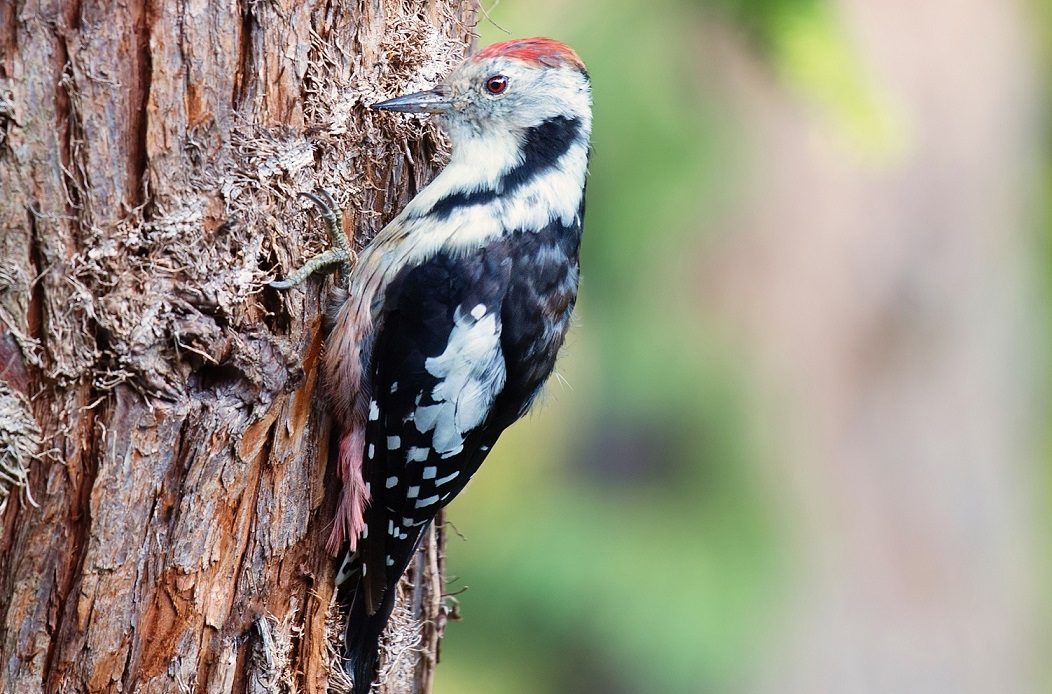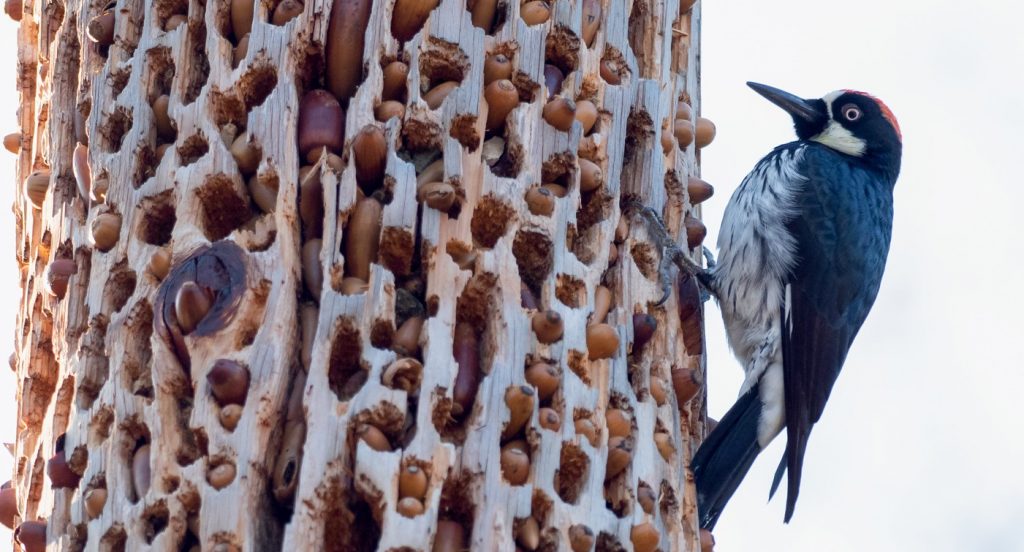

We’re here to help! Wild Yards is a completely free website that is 100% dedicated to helping you create a wildlife-friendly, sustainable yard. Read more
WildYards is reader-supported. When you buy a product through a link on our site, we may earn a comission. Every product is independently selected by our (obsessive) editors and our reviews are unbiased and objective. Read more about our mission or our privacy policy.
Woodpeckers – given their name – spend a lot of time drilling into wood. But what are they actually pecking for? Do woodpeckers eat wood while they’re pecking, or do they find other things to eat?
No, woodpeckers do not eat wood. It’s simply a means to an end – they peck at wood to make homes and to find a variety of insects hidden within the bark of dead or dying trees.
What Do Woodpeckers Eat?
Woodpecker diets are impressively varied – here’s what they love to eat.
Insects and Grubs
Woodpeckers usually eat a variety of insects that are found within the trees they peck at. In fact, they peck to hunt out ants, grubs, and various larvae. This is also why you may come across trees with seemingly random holes in them – it’s here where the woodpeckers have retrieved their food from.
Some woodpeckers – and we’ll go into this in a little more detail below – are known to really ravage bark to pull out legions of ants and other insects hidden in trees. But don’t worry, woodpeckers don’t normally kill trees outright.
Seeds and Nuts
Woodpeckers also love to consume a variety of nuts and seeds, too. Shelled, hulled, or otherwise, peanuts and sunflower seeds tend to be big favorites of woodpeckers when they appear in their feeders. Several woodpeckers also enjoy eating acorns.
Some yard owners also like putting peanut butter out for their local woodpeckers to enjoy. It’s a tasty treat, but can be loaded with sugar – so it’s normally best to treat them with the natural nuts and seeds they’ll find in the wild.
Fruit
Various woodpeckers do also enjoy hunting for fruit – such as oranges, strawberries, cherries, and berries.
Again, some yard owners have also adapted to this love of naturally sweet goodness by leaving out fruit jelly for them to enjoy. As above, be careful with artificial sugars and sweeteners – go natural.
Sap
Some species of woodpecker, known as sapsuckers, even go for the sweet, sticky insides of certain trees to satisfy their cravings. However, sap tends to be a ‘last resort’ meal for many woodpeckers, given that they prefer a diet of insects and nuts, on the whole.
That said, it’s not uncommon to find trees damaged by sapsuckers across the country. It’s thought that the drilling they do can actually help other animals access food, too.
Suet
Suet isn’t something woodpeckers will ever find in the wild, but it’s a common treat garden owners put out for their birds in feeders. This tends to be a fatty, peckable lump of nutrients (derived from animal produce) that you can buy from most butchers. Of course, if you are an observing vegetarian or vegan, you should avoid suet altogether.
Suet remains a favorite for many different wild birds, too. There are also ways you can make your own suet from home, too.
Suet contains a lot of nutritional value for woodpeckers and can help to keep them energized throughout the day. You can easily buy it from your local butcher, or even find stores that stock it online.
Do All Woodpeckers Eat the Same Things?
Not all woodpeckers have the same diets. Across the US, you may find that pileated woodpeckers, for example, have a taste for carpenter ants and various berries. Downy woodpeckers, meanwhile, prefer to feast on seeds and millet – and may even be dependent on what you put in your woodpecker feeders. Woodpecker diets will vary during the winter, too.
The various woodpecker species of the US will have regional diets based on what’s available to them. However, it’s always a good idea to look for a few treats to leave out for them to help supplement their hunting. Fill up a woodpecker feeder, and you may notice a few visitors flocking to your yard.
Why Do Woodpeckers Peck Into Wood?
One of the other main reasons why a woodpecker could be pecking on wood is to build its nest. You may see two woodpeckers pecking relentlessly at the same spot for days – this is because woodpeckers build their nests together as pairs. It can take a few days for a woodpecker to build a hole big enough for the two of them and their nest.
Acorn woodpeckers, for example, are great examples of birds that peck wood to create storage space. They will willingly peck into trees to make small hollows where they can store food (acorns, funnily enough), for later. They are rather like squirrels in this regard, only they have an extra tool to create holes with!

Woodpeckers also peck on wood to attract mates. The vibrations made in the wood allow others in the vicinity to know that they are there. They are often attracted to the noise and come to meet their potential suitors. It is rather like a mating ritual or dance.
Woodpeckers will make these displays not purely in the wood and bark of trees, but also peck loudly into telegraph poles, fencing, and more. You may even hear woodpeckers drilling onto metal during the mating season. This can help many woodpeckers find mates for life!
As mentioned, woodpeckers will also peck away at trees with their beaks in an effort to find insects and grubs. By pecking, they can then listen carefully for whether or not there is movement on the other side of the bark. The pileated woodpecker, for example, is famous for pecking furiously into bark, making incredible holes and cavities in trees. This is normally so they can hunt down carpenter ants, some of their favorite food.
What Can I Feed the Woodpeckers in My Garden?
As mentioned, some of the woodpeckers’ favorite feeder food include peanuts (and peanut butter), black oil sunflower seeds, berries, pecans, and acorns. However, if you’re looking for a woodpecker superfood that will keep your birds well-fed, you should consider leaving out some suet. When attracting woodpeckers to your garden, it’s important to consider a balance.
